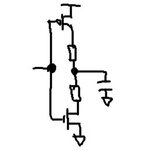hejinjie
Newbie
- Joined
- Aug 8, 2009
- Messages
- 5
- Helped
- 0
- Reputation
- 0
- Reaction score
- 0
- Trophy points
- 1,281
- Location
- Wuxi, Jiangsu, China
- Activity points
- 1,326
hi,
anyone got an idea to decrease the voltage of either rail of inverter output signal?
I need a 100mV~1.2V output signal and a 0V~1.12V output signal. Error within 10% @ 100mV and 1.12V.
can you help me with this design?
tinier, the better
Thanks in advance.
regards,
Kevin
anyone got an idea to decrease the voltage of either rail of inverter output signal?
I need a 100mV~1.2V output signal and a 0V~1.12V output signal. Error within 10% @ 100mV and 1.12V.
can you help me with this design?
tinier, the better
Thanks in advance.
regards,
Kevin
